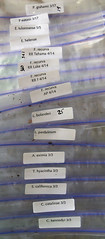The madness
Every single seed I ordered this year requires stratification (except potentially for the alliums, which I can't figure out), so this weekend I painstakingly assembled a drawer full of dime bags in the fridge:
- Aquilegia eximia
- Allium amplectens
- Allium bisceptrum var. bisceptrum
- Calochortus catalinae
- Calochortus kennedyi var. kennedyi
- Erythronium helenae
- Erythronium tuolumnense
- Fritillaria recurva (4 populations)
- Lilium bolanderi
- Lilium pardalinum ssp. pardalinum
- Penstemon eatonii var. eatonii
- Penstemon grahamii
- Silene californica
- Triteleia hyacintha
Hopefully I'll have time so say something more substantial soon.
Labels: seed


5 Comments:
Good luck with Lilium pardilinum. I've tried a few different things, but no luck yet.
I'm sure I'll kill it if I ever get it to germinate. FWIW, Alan Bradshaw (good seed source) suggests 3-4 months of warm stratification followed by 2-3 months of cold stratification, but the Pacific Bulb Society people persuaded me to skip straight to the latter. I'm also going to try half the L. bolanderi outside next fall.
Check out McRae's Lilies for info on "delayed hypogeal germination."
And Chuck -- feel free to share any seed tips you might have. Not my forte.
I'm still a seed amateur myself.
I usually start by consulting Dara Emery's book Seed Propagation of Native California Plants (on Amazon right now for $25, used). He was an expert, and they use him at the San Francisco Botanical Garden with generally good results.
L. pardilinum, per Emery: 3-6 months warm, followed by 2-3 months cold.
My L. pardilinum seeds had 2 months of constant warm (around 80 deg F) on a heating pad in the garage before I put them outdoors a month ago when it was notably cold. I'm still waiting...
Norman Deno's book (via JL Hudson) recites sowing L. pardilinum seed outdoors in September, waiting a year, then cooling to 40 degrees F until the cotyledon leaves emerged, followed by three months at 70 degrees F until the true leaves emerged. Sheesh!
Sometimes I modify Emery (or whoever) with my own ideas. This usually involves sowing seeds shallowly in well-moistened sterile mix, sealing the flat in a plastic ziploc bag (with lots of air), and providing diurnal temperature fluctuation (on a heating pad in the garage during the day, outside exposed to cold at night), and waiting until something happens or I lose hope.
When I lose hope, I take the flat out of the bag and leave it outside. Sometimes I feel reinvigorated with hope and I'll resume the diurnal fluctuation. Datura wrightii recently germinated under this treatment. (Per Emery, D. wrightii requires no special treatment.)
I try to change the air in the ziploc every day to keep it fresh. Overall, this would be a way to mimic the natural conditions of most Mediterranean climate plants.
For seeds with hard coats, I always immerse them in hot water and let them cool to room temperature overnight. Then in the morning, I change the water with fresh room temperature water and let them soak for the rest of the day, followed by sowing at night, as above.
I've also experimented with soaking seeds in dilute bleach and/or hydrogen peroxide to help abrade the seed coat, but I don't have anything really conclusive to report about that.
For seeds known to require cold stratification, I usually put them in a baggie with a moistened mixture of equal parts perlite and vermiculite and refrigerate them for up to two months. (When I did this with Berberis nevinii, the radicals emerged before I noticed them and I think the seedlings may have died upon sowing. So you have to check seeds under these conditions more regularly than I apparently did.)
The only point I would emphasize as being most important in my own experience and from talking to others is to sow native seeds shallowly. Like, barely covering them at all. But I also like to press the seeds snugly into the sowing mix to provide good contact and so promote softening of the seed coat.
Other than that, it feels like a crapshoot. The people I know who seem to have the best results all sow their seeds in flats outdoors in Oct/Nov, and wait.
***
Please do forward me the list, or source, or whatever you quoted in the comments at whoreticulture: lcbii at yahoo dot com, or post it in the comments. Thanks!
Shit, I was afraid you were going to say something complicated.
BTW, Bradshaw suggests cold stratification times of up to 4 months (for E. tuolumense), presumably depending on elevation.
Thanks for e-mailing me that list! I'll take a look at it now.
Post a Comment
<< Home